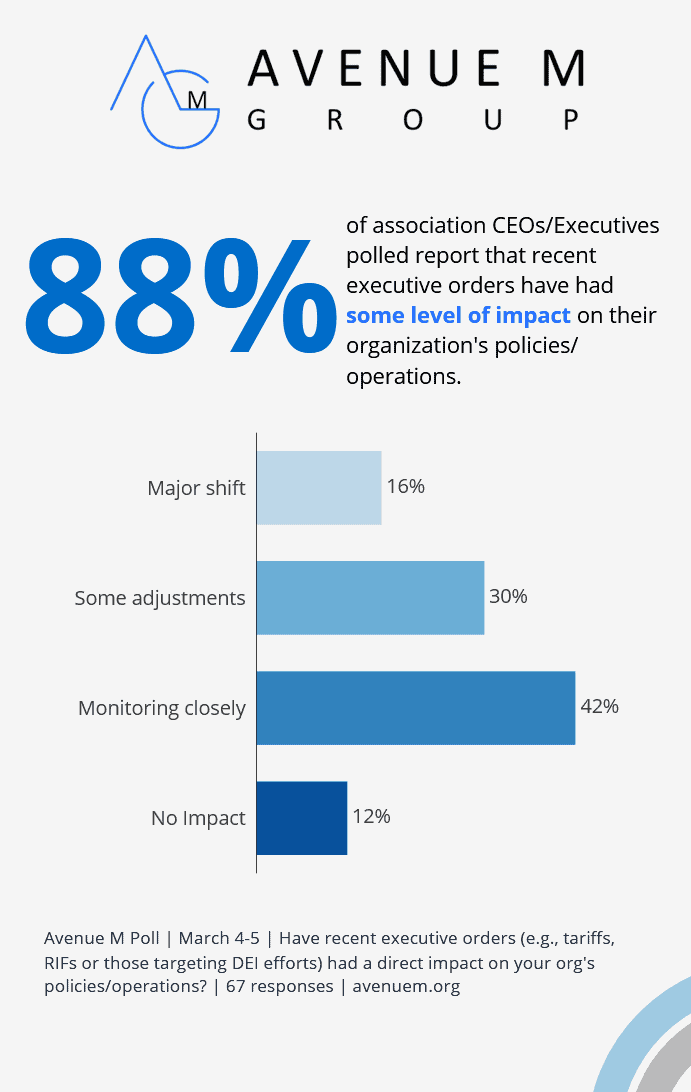Executive orders, tariffs, and more are shaking up industries, and associations are feeling the heat. Leaders are responding to this rapidly changing landscape with (no surprise) dexterity, resolve, and by keeping members in the loop.
A recent wave of business changes from the White House has quickly upended the course of many organizations, pushing them to revise and adapt their policies and structures on the fly. From tariffs and layoffs to executive orders targeting diversity, equity, and inclusion (DEI) efforts, these moves are having a big impact across industries.
How Are Associations Responding?
 A recent Avenue M quick poll of 67 association executives found that most are feeling the effects of recent executive orders in some way, with only 12 percent reporting no impact. While 16 percent are seeing major shifts to their organization’s policies/operations, a larger portion (42 percent) are keeping a close eye on things or making some adjustments (30 percent). This suggests a lot of uncertainty and a need to stay flexible as policies evolve.
A recent Avenue M quick poll of 67 association executives found that most are feeling the effects of recent executive orders in some way, with only 12 percent reporting no impact. While 16 percent are seeing major shifts to their organization’s policies/operations, a larger portion (42 percent) are keeping a close eye on things or making some adjustments (30 percent). This suggests a lot of uncertainty and a need to stay flexible as policies evolve.
Advocacy, Member Support, and Risk Assessment
One executive–who indicated their organization is making some adjustments to their policies/operations–said it’s “more than a shift, it’s caused major headaches,” adding that they are rewriting policies, meeting with members, and preparing to share information to help members engage with their local representatives soon.
Executives who are closely monitoring the situation said they are focusing on advocacy, member support, and risk assessment. Many are ramping up lobbying efforts, strengthening relationships with lawmakers, and collaborating with allied organizations on advocacy and letter-writing campaigns. Others are creating task forces to determine priorities, assessing risks to federal funding, and equipping members with resources to engage at both the federal and local levels. Additionally, some have issued statements reaffirming their values and seeking input on member needs.
Executives experiencing major shifts are increasing advocacy efforts and focusing more on regulatory and policy changes. They are engaging both members and staff in responding to tariffs and executive orders while creating spaces for members to discuss the impact of and share resources to adapt to new policies.
Staying in the Game During a Trade War
Another curve ball is the trade war brought on by the tariffs the U.S. is imposing on Mexico, Canada, and China. Willis Turner, CAE, CSE, CMS, president and CEO of Sales & Marketing Executives International (SMEI), is helping his members navigate the situation. In a blog post, he notes that while trade wars can make it tough for businesses–with tariffs, supply chain issues, and new regulations–organizations that adapt can still grow.
Expanding into new markets, reworking supply chains, and using digital platforms can help. Partnering with local businesses, staying on top of rule changes, and tapping into government export programs also make a difference. The key is staying flexible, proactive, and ready to adjust.
Adapting Swiftly to Change
As executive orders and broader issues continue to reshape the environment, associations are staying nimble, adjusting their strategies, and putting extra effort into supporting their members. While some are dealing with bigger changes, most are keeping a close eye on things and adapting as needed. Overall, associations are proving their resilience and navigating these challenges with a focus on long-term success and member support.
Want to participate in future text polls? You can sign up HERE.
For more insights on strategies for adapting to sweeping changes, read Avenue M’s quick summaries of the following resources, and click the links below.
The Board’s Role in Times of Crisis
Nonprofit boards are facing chaos as they navigate strategic plans amid an unpredictable political landscape. With shifting regulations and uncertainty around funding, boards must balance long-term goals with immediate challenges.
One expert advises boards to focus on mission stability, supporting staff leadership, and adapting strategy as needed while maintaining their oversight role. Strong board-CEO relationships are key, with transparency and accountability guiding decisions. Boards must provide steady leadership, just as they did during the pandemic.
The CHRO Response to Trump’s Executive Orders on Diversity, AI, Hiring, and Remote Work
Trump’s executive orders on workplace policies are forcing HR leaders to quickly adapt, especially in areas like DEI, return-to-office rules, AI, and hiring. A SHRM survey found that nearly two-thirds of HR professionals feel unprepared to handle the changes, highlighting widespread uncertainty in the field.
SHRM introduced resources to aid HR leaders: a First 100 Days hub page, an EO Impact Zone hub page, and a five-step “BEAM Test” (Belonging Enhanced by Access through Merit) for CHROs to assess if their DEI programs will face scrutiny in the new environment.
Paramount Rolls Back Diversity Hiring Targets
Among the many companies referenced in the article, BlackRock–a formerly strong DEI advocate–has scaled back its DEI commitments in its latest annual report, removing past references to its DEI strategy and workforce diversity data.
BlackRock’s revised language now focuses on fostering diverse perspectives without using the DEI acronym:
- BlackRock emphasizes a connected, inclusive culture aligned with business goals.
- The firm aims to attract top global talent to serve clients effectively.
- It prioritizes diverse perspectives to prevent groupthink.
Want to be the first to be notified about articles like this? You can learn more about Avenue M’s texting poll service HERE.
Contributors: Sheri Jacobs, FASAE, CAE & Lisa Boylan
Image: Adobe Stock